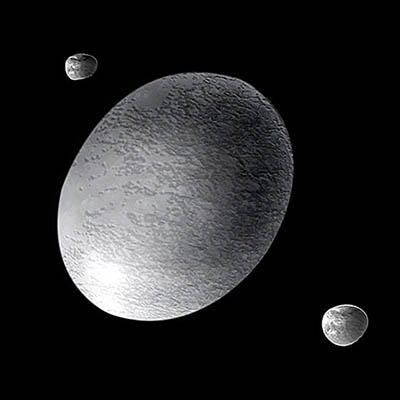Haumea
Haumea is named for the Hawaiian goddess of childbirth and fertility.
Oddly-shaped Haumea is one of the fastest rotating large objects in our solar system. It completes a turn on its axis every four hours. The quick spin elongated the dwarf planet into the unique shape astronomers discovered in 2003. It is roughly the same size as Pluto. Like Pluto and Eris, Haumea orbits our Sun in the Kuiper Belt, a distant zone of icy objects beyond the orbit of Neptune. It takes 285 Earth years for Haumea to make one orbit around our sun.
It is possible a massive impact billions of years ago set off Haumea's spin and created its moons. Haumea's known moons are Hi'aka and Namaka. Astronomers believe Haumea is a made of rock with a coating of ice.
Haumea was discovered in March 2003 at the Sierra Nevada Observatory in Spain. The official announcement of its discovery came in 2005, the same year its moons were discovered.
On September 17, 2008, it was recognized as a dwarf planet by the International Astronomical Union (IAU)
The moons of Haumea
Two satellites have been found in orbit around Haumea: Hi'aka and Namaka, both were discovered in 2005 and are of substantial size. Hi'aka is the patron goddess of the island of Hawaii and of hula dancers. Namaka is a water spirit in Hawaiian mythology.
Hi'aka
Hi'aka was the first of Haumea's moons to be found. It has been nicknamed "Rudolph" by the Caltech team which discovered it. It orbits Haumea once every 49 days at a distance of about 49,500 km, with an eccentricity of 0.050 and an inclination of 235°. Its measured brightness suggests a diameter of about 350 km, assuming it has a similar brightness to the primary. This would make it larger than all but four of the asteroids (1 Ceres, 2 Pallas, 4 Vesta, and 10 Hygiea) in the main asteroid belt.
Namaka
Namaka is the smaller and inner moon of Haumea at a distance of about 39,000 km from the primary. The orbital period is 34 days and the inclination 39±6° from the larger moon. Its diameter has been estimated at about 170 km.
Haumea ring
Haumea is the first known Kuiper belt object to have rings. Scientists announced the discovery in 2017 after watching the dwarf planet pass in front of a star. It is estimated a ring of 0.5 opacity, 70 kilometers wide and a radius of 2,287 kilometers.
| Haumea | |
| Discoverer | José Luis Ortiz Moreno et al. |
| Discovery date | March 7, 2003 |
| Diameter | ⁓ 1960×1520×1000 km |
| Density | 2.6-3.3 g/cm3 |
| Eccentricity | 0.189 |
| Inclination | 28.19° |
| Semi-major axis | 43.34 AU |
| Perihelion | 35.16 AU |
| Aphelion | 51.53 AU |
| Orbital period | 285.4 years |
| Albedo | 0.7 |
| Absolute magnitude | 0.1 |
Information from: NASA, Wikipedia, David Darling’s encyclopedia and Nature.

